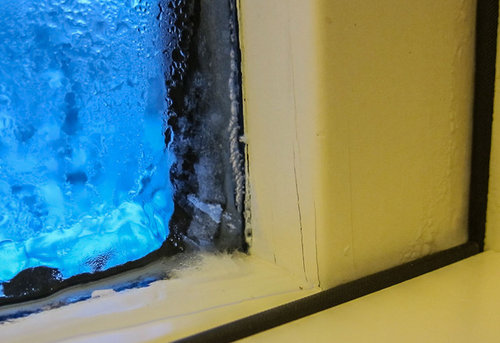Condensation and ice on windows - help!
Not strictly speaking a new home, but our builder told us to expect year-over-year improvement as the wood dries out. Instead we are experiencing more condensation and ice buildup on our windows than in years past. 4-year old 2900 SF very tight, well insulated home in Duluth MN. Running a Venmar HE 1.8 HRV at full blast continuously. Windows are well sealed, double paned low-e. This year, we are getting more condensation and icing whenever the outside air temp is Is our HRV too small, or am I doing something wrong? We are not generating more water into the air (cooking showering etc.) than in years past. Any ideas?

Comments (26)
GreenDesigns
10 years agoSounds like lower quality windows were used. "Double pane" doesn't mean a whole lot. IF they were doing their job, you might get some condensation, but you wouldn't get any icing. If you live in a location that has a lot of subzero temperatures, perhaps triple pane would have been a better choice. Also, what type of humidity regulation do you have with your heating system? Very tight homes can have issues with too much humidity in winter and may need dehumidification, which is contrary to what many people believe needs to happen in winter. You need a hygrometer reading in several spots in the home. And you need to check out how your baths and kitchen exhausts are terminated and if they are working properly.
This post was edited by GreenDesigns on Wed, Dec 11, 13 at 9:34
lolauren
10 years agoIs this issue on all of your windows? On the windows with the issues, what kind of window treatments do you have? If it's only on certain windows, what direction do those windows face?
LawPaw
10 years agoOften it can be a matter of air flow not getting to the window to move the warm air over it and take the moisture away.
Try running a fan on it when it gets icy, if that helps try to figure out a better way to get the air exchanged over it on a more permanent basis.
annkh_nd
10 years agoYou've had a ton of snow already this year (hooray! We're skiing Spirit after Christmas!). Part of the increased humidity in the house might be from snow evaporating off coats, boots, mittens.
It's also really, really cold (I'm in North Dakota, it was -20ð when I go up this morning, and there is ice on some of our windows). The colder it is outside, the more likely you are to see condensation. How cold was it when you first noticed the moisture?
So reducing the inside moisture is the first thing. Does everyone use a bathroom fan when showering - and let it run for 10-15 minutes after? Do you always use a range hood when boiling noodles, or other steamy foods? We used to have 3 large aquariums in our house, and controlling humidity was a big challenge. We ran a dehumidifier near the largest tank all year long.
A friend of mine goes around the house every morning and wipes the windows down with a bath towel, which she then throws in the dryer. That's a quick and easy way to remove moisture.
Since the condensation is really hard on wood windows, this is a problem you need to address. You can put 3M plastic on the windows, to protect the windows from ice, but the moisture will just condense somewhere else where you can't see it, so that would treat the symptom, but not the problem.
worthy
10 years agoThough it can help by bringing in dry outside air, an HRV/ERV is not a dehumidifier. Buy a hygrometer to check rh. If the rh exceeds 35% on cold days, buy and use one (or more) dehumidifiers to reduce the humidity.
LawPaw
10 years agoWarm indoor air will always have enough moisture to cause frost when it is suddenly dropped below freezing (unless it is uncomfortably dry so that the frost point is well below freezing). Put a glass in the freezer and take it out and see what happens regardless of what you think the humidity level is.
If the interior window is allowed to get below freezing, it will frost.
Your problem is a combination of the window not being insulated well enough to keep the interior above freezing and your air exchange system (HVAC) not moving warm air across it well enough to keep the interior temperature above the dew (or frost) point.
duluthjeff
Original Author10 years agoThanks for all you responses.
We have H-windows which are double paned and low-e, argon filled wood core windows. They are used in Passive house construction, so I don't think they are the problem. It has been cold this week (10-20 below zero). When my wife pointed a fan at a window, it remained dry and ice-free. so what we have seems to be the result of a cold convective current moving down the inner face of the glass that reaches freezing by the time it gets to the bottom. The HRV is exchanging indoor and outdoor air at full blast, but even still, the relative humidity indoors must be high (though it doesn't feel humid).
I will buy a hygrometer, and set up a dehumidifier to see if that helps. The problem will go away when it warms up, but I'm afraid the paint on the windows will be damaged soon.
I'm wondering if the HRV is too small for the job.
rollie
10 years agoHeres a decent read for you, explaining some of the physics behind winter condensation..
One other thing to consider, the condensation on windows is the "proverbial" canary in the mine shaft.. If you have excessive condensation on your windows, its very likely that you also have moisture/ice forming in other areas of your structure, that can cause as much, or more structural damage than the damage to to windows.
Areas that are readily available to look at/insepct would be your attic space, and your rim joist space. Take a peek in your attic at the roof sheathing/rafters. If there is excessive frosting there (there wont be water there, because the temps will be too cold) . If there is nothing there, then you have a relatively tight cieling plane in regards to air movement. If there is excessive frosting there, then you need to look at potential air leakage pathways. (recessed cans, attic bypasses/soffitswith connectivity between the attic and an interior wall.
Another easy place to inspect would be the rim joist area. If this area has foam for insulation, then youre good. If it has some sort of fibrous insulation, then pull a piece back and inspect. My guess is you will find extensive frost there also..
Any place there can be air movement between conditioned/unconditioned space, there will be moisture/frost, when you carry a RH like you have. Leaky outlets and switches will allow condensation inside the stud cavity that you cannot inspect. These are dependent on wind direction, with positive and negative pressure on the house..
Here is a link that might be useful: Fogged Up
This post was edited by rollie on Thu, Dec 12, 13 at 9:33
GreenDesigns
10 years agoWindows are basically holes in a home's structure that allow all of the exterior conditions infiltration into the home. That's why window selection is important. If good windows are chosen and working properly (no blown seals allowing the gas to escape) then you might get some condensation on the windows in cold temperatures. But, if the windows are getting cold enough to have ice form on them, you've got MAJOR issues with the quality of the windows, their seal, or the insulation/air seal around those windows.
Because the pic shows uniform ice distribution across all of the glass, it's not the insulation/air sealing around the windows. It's the windows. Either the seal between the panes has been compromised, or they weren't the correct choice for the locale from the beginning. You should NEVER get ice on a modern insulated window if you chose the correct window and it's working properly.
annkh_nd
10 years agoGreendesigns, if it is cold enough outside (like the -20ðF Jeff has had), it is possible to get a little ice on windows. I've had some in my house this week on the north side of the house, and my windows are 3-yr-old Marvin Infinity. As soon as it warmed up to close to 0ð, the ice disappeared. Unfortunately, our forecast for the next 10 days has more days below 0 than above.
In Jeff's photo, it looks to me like there is ice along the bottom of the pane, and condensation on the glass - not ice covering the whole window.
lolauren
10 years agoOur weather only has gone down to 4f, but our wind chill approached the OP's temps. We had condensation on two north facing windows for the first time this year. There was another window on the west side of that room without condensation. The issue, for us, was that the new (double-honeycomb-w/-side-rails) window treatments were so good at insulating, they weren't letting enough warm air reach the window panes and heat them. The extra exterior cold of no direct sunlight on those north-facing windows didn't help.
I asked above if you had issues on ALL your windows, if you had certain window treatments, etc. I didn't notice a reply, so I'm not sure this helps...
What I did, was first adjust the RH on my thermostat. It was set too high for the really cold weather we were having. Also, when I showered, I made sure to keep all doors to that room closed with the fan on. (Previously, doors were left open.) In addition, I set the thermostat higher than I normally would to keep the inside of the house consistently warmer. I read online that opening window treatments during the day will allow the air to circulate better, if that is your issue. I didn't need that step as the above fixed our issue.
duluthjeff
Original Author10 years agoRollie, thanks for the article. It is a great review of the issue. We did both a blower door test (which found the house to be very tightly sealed) and a thermal imaging test of the walls and ceiling the first winter we were in our new home. We have three dogs, two rabbits, dozens of plants, and two humans living in here. After reading through your recommendations, I am convinced that we are producing too much water vapor and/or not getting rid of it fast enough. I have ordered a hygrometer to verify this.
Mechanically, I think one problem is that the intake and exhaust pipes from the HRV both terminate under the south deck which is now surrounded by snowdrifts that effectively seal off two of three sides. The result is that there is pooling of intake and exhaust air - in effect recirculation.
I will tackle this next. Since it got only to zero degrees last night, the condensation is improved. Thanks again !
rollie
10 years agoOnce the conditions exist for ice to form, it exacerbates itself by moving the edge effect inward, causing more condensation.. H windows are traditionally considered a pretty good option in a heating climate. Of course, if they werent foamed in, or insulated around, that would promote a cooler frame/glass edge.
I have 26 new Marvin integrity windows I jsut installed in my 1928 farm house. I shot them on Sunday with a laser thermostat. Outside temp was -8. Edge of the glass was 49 degrees, center of the glass was 61. No condensation noted. But, my house is considered very leaky by todays standard.. Ive been tightening it up, but want to be very careful about tightening it too much. I voided the attic of all insulation (nasty, nasty job) and installed 1 inch of spray foam and 10 inches of cellulose over the top.. No condensation on the windows, tells me I can do more yet.
At this point in time, Im not blaming the windows.. Like I sad, theyre the canary in the mine shaft. Its your warning sign.
Jeff, I would still request that you do the inspections I indicated in the attic and rim joist to just to satisfy my curiousity :)
I agree, you are carrying too much RH. I would guess that the plants are the major culprit. Do you water your dogs inside? If so, if theyre anything like a Lab, theyll slobber more water n the floor than they take in..
The Ventilation system may sound like its running on high speed, but if its blocked up, the fan will actually run at a higher speed and move no air. Kind of like when your leaf blower gets against your hip on the intake side. Rpms go up, volume goes down.
threeapples
10 years agoWe also have a lot of condensation. Ours hold water all day. We have Marvin simulated divided light windows. I can't go around wiping them all day and am worried the wood will rot.
LawPaw
10 years agoAll my windows are new Marvin Impervia windows. They all have frost formed on the bottom of their interior panes. Every single window.
The reason is that we haven't turned our air exchanger on yet, until we are done with mudding we are heating the house solely through the basement floor radiant heat. The interior is around 50 degrees, and was dry until we started mudding.
I have not doubt all frost and condensation will go away once our air exchanger kicks in. Without air moving over the surface of the window, the cold air will sit and collect on the bottom of the sill. This is especially the case above a counter.
You're going to be fighting a painful uphill battle trying to solve the problem by reducing the overall humidity. A humidity level below a frost point (possibly well below a frost point) is not a comfortable humidity level. I get nose bleeds when it gets too dry.
annkh_nd
10 years agoLawPaw, I get nosebleeds too. But there is a lot of room between "so dry my nose is bleeding" and "my windows are covered in condensation all day". The trick is to find that balance point.
My mom's house is dry, and when I stay with her for a few days, I make sure I drink lots of water, and use vaseline in my nose to keep it from drying out. Small price to pay to prevent water damage in unseen areas of the house. As others have mentioned in this thread - if there is that much water on the windows, it is condensing in other parts of the house that you can't see.
Here is a link that might be useful: Ideal winter humidity
LawPaw
10 years agoannkh, I disagree with that chart. Ideal humidity doesn't change with the seasons, its always between 40% and 60%. At 15% humidity you are significantly increasing the risk of respiratory problems. Also, the lower the humidity the higher temperature you need to feel warm.
It seems to me like a better solution is to insulate the best you can, then to make sure warm air is moving over all the places cool air wants to collect. This way you avoid condensation while keeping the space more comfortable.
At 15%-20% humidity you are going to need the temperature several degrees warmer to feel the same warmth as 50% humidity. It may not be more efficient to dehumidify than it would be to move the air around the cool places.
worthy
10 years agodozens of plants
Not much theory needed to figure out the main source of moisture.
I was once asked by a neighbour to check out why her walls were dripping with water. Jeeze, could it be the giant pots boiling away on the stove with no vent hood.
Similarly, a relatively tight home I finished in '91 had water dripping from the thermal pane windows. As noted by other posters above, part of the problem were the windows themselves, several of which had failed seals. The other part was that the homeowner had insisted on two large humidifiers on the single furnace. Old habits bred of living in leaky homes are hard to break.
duluthjeff
Original Author10 years agoI was over visiting a friend yesterday. Lives in an older (~1940s) home with newly replaced windows. No condensation at all. His hygrometer read 27%. He also has no houseplants or dogs. Still waiting for the hygrometer here from Amazon...
jimandanne_mi
10 years agoFirst I haven't read every post so I may repeat something said earlier.
We too have a Venmar 1.8 HRV. Note that there is a difference in operation between an HRV and an ERV. The ERV recycles home moisture back into the home, the HRV does not so it does reduce household moisture.
How much flex duct do you have in you installation? Flex duct perfectly installed creats a lot more static pressure than metal ducts. Turns out we have a lot of flex and a flow test on our HRV system showed very low flow levels as a result. I suggest you have your HRV system checked for flow volume; you may be surprised at how little air you are really exhuasting.
Some Venmar 1.8 numbers:
CSA F326
10cfm per Kitchen Dining room Living room Master bedroom(20) Bedroom #1 Bedroom #2 Bedroom #3 Washroom #1 Washroom #2 Basement (20)
Total 120 cfm at high speed
ASHRAE Standard 62-2001
Volume of basement Volume of main floor Volume of second floorTotal
(7,360 ft3) (7,360 ft3) (7,360 ft3)
(22,080 ft3)
x .35 7,728 ft3/hr ÷ 60 (min/hr)
129 cfm (high speed)Metal Duct capacity (short runs minimum elbows)
Duct Diameter Recommended Airflow
Maximum Airflow
4âÂÂà40 cfm 60 cfm
5âÂÂà75 cfm 110 cfm
6âÂÂà120 cfm 180 cfm
7âÂÂà185 cfm 270 cfm
8âÂÂà260 cfm 380 cfmGo to venmarces.com and get the manual for your unit.
After you have resolved these other issues and you still have the problem try interior or exterior storms.
One more point. A parcel of air at 70 degrees and 25%RH will reach 100%RH at 30 degrees. If your indoor RH is at 25% you will have condensation on the first 30 degree surface. I think Rollie mentioned that and it brings other issues into the picture. For instance, air leaking through a wall, think switches and outlets, and hitting a 30 degree surface; that is not good! Go to buildingscience.com for a lot on this subject.
Hope this helps!
Jim
LawPaw
10 years ago27% is not a comfortable moisture level long term. You also need to consider what that level will do to your woodwork. You may see cracking and gaps in your floor.
For comparison, the Sahara desert is 25% moisture.
We lived in a 1910 home with radiant heat up until around a year ago. We had no air exchanger. All our windows frosted near the sill.
We replaced the windows and would run fans in key locations when it was really cold. We didn't have any condensation issues and our humidity was around 50%.
rollie
10 years ago27-40 will be manageable and should be your target numbers Jeff, given your location.
I just checked Duluths current temp. 9 degrees and 86% RH outside. Cold air isnt dry, until you bring it in, or it leaks in.
When you get your hygrometer Jeff, take notes on a room by room basis to begin with to establish a baseline...Its actualy quite fun doing this type of diagnostics.. Youll learn alot about your structure..
ilmbg
10 years agoJust a comment when I saw this thread...
My mother bought a new home a couple years ago in Rapid City SD. The builder tauted the "very tight envelope, triple paned window, the super-insulated hot water heater(forgot the name-had 9" insulation and looked like a rocket ship). The builder promised a total utility bill of $200 max for the entire winter. Well, the utility bill was fine, but I hated to be in the house in the winter due to the humidity! The tight envelope did not let the house breath-the dampness from the crawlspace came up...bringing a faint 'dirt' smell with it. The neighbors used dehumidifiers continuously to control the problem. Seems too tight an envelope does not let a house breathe...dekeoboe
10 years agoSeems too tight an envelope does not let a house breathe...
Which is not a problem because a house does not need to breathe. A tight house will need an air exchanger though.
frozenelves
10 years agoHi Jeff,
I'm in Duluth also. Been wanting to build for 4 years now but haven't been able to yet. Do you mind telling me who your builder is? Were you happy? You can email me if you'd rather. This weather stinks doesn't it?



















rollie